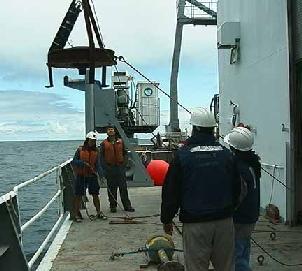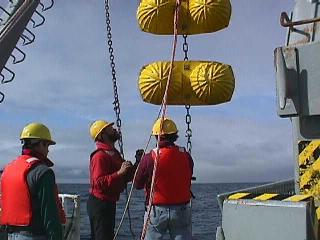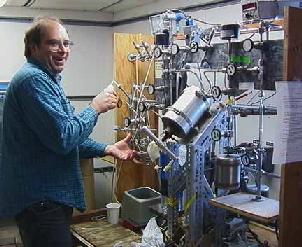WHAT'S NEW:
BACKGROUND:
Mission
Project Description
Cruise Plans:
Participants
Technology (ROV, ships, etc.)
Future Plans
Results:
1998 NeMO Cruise
Axial 1998 "Eruption"
Logbook
June 26, 1999
June 26, 1999
Contents:
- News from Thompson
- News from Wecoma
- Participant Perspective
- Logbook from Teacher at Sea
- Question/Answer from shore to sea
Thompson Science Report
Science Report - Saturday, June 26
Ships Location: 45 55.9/129 59.0
 Deployment of the range meter for calibrating the transponders used for ROV navigation underwater. |
Wecoma Science Report
See Wecoma's teacher log for information.
Listing of all Science News postings
Life at Sea: Participant Perspective
Thomas Chapin
Monterey Bay Aquarium Research Institure (MBARI)
 Hi. I'm Thomas
Chapin, a scientist from the Monterey Bay Aquarium Research Institute
(MBARI, www.mbari.org). I work at MBARI
with Hans Jannasch, Geoff Wheat,
and Ken Johnson developing long term underwater samplers (Osmo
Samplers) and chemical analyzers (Osmo Analyzers) for monitoring hydrothermal
vents. Scientists have been able to get out to the Juan de Fuca ridge
fairly often and have begun to develop some theories on the chemical evolution
of hydrothermal systems from eruption to when the vents die out. However,
the chemical sampling has mostly been accomplished with ships and ROVs
which, if you're lucky, get out here once or twice a year for a few weeks.
That's like only seeing 10 minutes of a 2 hour movie; you get some
idea of the plot but you're making educated guesses about what happened
before you got there or what happens after you leave. That's where the
MBARI folks come in, we put down Osmo Samplers and Osmo Analyzers that
continuously collect samples and data for up to a year.
Hi. I'm Thomas
Chapin, a scientist from the Monterey Bay Aquarium Research Institute
(MBARI, www.mbari.org). I work at MBARI
with Hans Jannasch, Geoff Wheat,
and Ken Johnson developing long term underwater samplers (Osmo
Samplers) and chemical analyzers (Osmo Analyzers) for monitoring hydrothermal
vents. Scientists have been able to get out to the Juan de Fuca ridge
fairly often and have begun to develop some theories on the chemical evolution
of hydrothermal systems from eruption to when the vents die out. However,
the chemical sampling has mostly been accomplished with ships and ROVs
which, if you're lucky, get out here once or twice a year for a few weeks.
That's like only seeing 10 minutes of a 2 hour movie; you get some
idea of the plot but you're making educated guesses about what happened
before you got there or what happens after you leave. That's where the
MBARI folks come in, we put down Osmo Samplers and Osmo Analyzers that
continuously collect samples and data for up to a year.
There are many potential problems with long term continuous samplers and analyzers including limited power, fouling of intakes, moving parts wearing out, etc. To overcome some of these major problems, we use osmotic pumps. These are pumps, which rely on osmosis, the principle that water will cross a semi-permeable membrane to try and balance outs the salt concentration on both sides. Since you have water moving from one side of the membrane to the other, you are effectively pumping it, and we can employ this idea to move samples and reagents. The coolest thing about the osmotic pump is that it requires no electrical power to move water! It also moves water very slowly, about 0.25 ml/day. Osmo Samplers continuously pull the hydrothermal water into a really long (>200m) coil of tubing. After a year, we pick up the Osmo Sampler and cut the tubing up, each meter of tubing is about 2 days worth of sample. So the Osmo Sampler requires no electricity and just sucks sample into a long coil of tubing. On the other hand, the Osmo Analyzer is an instrument, which does require some battery power to continuously measure iron (Fe) concentrations in hydrothermal vents. Osmotic pumps are used to add reagents to the sample to make a colored compound. The color intensity, which is proportional to the Fe concentration, is then measured every 30 minutes. A data logger and battery pack provides the program and power to run the electronics. I'll be recovering two Osmo Samplers, which were deployed last year and bring them back to lab for analysis. This data will be incredible since we'll be able to see changes in hydrothermal chemistry over the entire year with almost a daily resolution. For this cruise, I will be deploying four Osmo Samplers and two Fe Osmo Analyzers, which will be picked up next year.
Listing of all Perspectives postings
Teacher At Sea Logbook
Day 11, Saturday 6/26/99
Our day was filled with a long tow-yo deployment along the Cleft segment. The sawtooth pattern of our tow was marked on the large chart on the lab's map table. More samples were collected for chemical analysis and interpretation.
Ron Greene,
Research Assistant OSU/CIMRS uncoils shiny copper tubing on the floor
of the dry lab. He then carefully measures and cuts the tubing into 2
ft lengths. Each tube is capped at both ends to keep them dust free. The
scientists later attach clear aquarium-type tubing to drain sea water
from the Niskin Bottles when the  rosette returns from the deep. Bubbles are removed by pounding on
the tubing with a small metal rod. I enjoy watching the scientists for
it is as if they are playing a percussion instrument in an orchestra.
Ron explains that gases
from the earth's mantle enriches the hydrothermal plume signal with both
3He and 4He (Helium). Both are stable isotopes with 4He being 1,000,000
times more abundant than 3He. The seawater holds many answers to questions
scientists ask. After collecting seawater into copper tubing, the dissolved
gases are later removed at the PMEL laboratory in Newport, Oregon. Helium
gas is conservative and inert and only affected by dilution from the vent
site onward. It does not decay nor react chemically or biologically with
other elements. It is an ideal tracer. In the Newport laboratory the collected
seawater is analyzed with a sensitive mass spectrometer to isolate helium
from the other gases. The 3He and 4He atoms are counted and information
of this important element in the Western Pacific is completed.
rosette returns from the deep. Bubbles are removed by pounding on
the tubing with a small metal rod. I enjoy watching the scientists for
it is as if they are playing a percussion instrument in an orchestra.
Ron explains that gases
from the earth's mantle enriches the hydrothermal plume signal with both
3He and 4He (Helium). Both are stable isotopes with 4He being 1,000,000
times more abundant than 3He. The seawater holds many answers to questions
scientists ask. After collecting seawater into copper tubing, the dissolved
gases are later removed at the PMEL laboratory in Newport, Oregon. Helium
gas is conservative and inert and only affected by dilution from the vent
site onward. It does not decay nor react chemically or biologically with
other elements. It is an ideal tracer. In the Newport laboratory the collected
seawater is analyzed with a sensitive mass spectrometer to isolate helium
from the other gases. The 3He and 4He atoms are counted and information
of this important element in the Western Pacific is completed.
The meals served aboard the Wecoma have been more than wonderful. The food is served cafeteria style with a menu posted on the bulletin board before each meal. Doug Capps, cook, and Lee Helton, messman, have provided us with a wide variety of culinary delights. We all enjoyed the fare this evening. Salad bar with prawns, Soup of the day: Chicken noodle. Fillet Mignon, New Zealand Rack of Lamb, baked Yams, green peas with proscuitto and onions, fresh baked rolls followed by desert: chocolate mousse. With meals like this I'd call Doug and Lee top class Chefs!
Have you eaten all your vegetables? To be a scientist it is important to be of strong mind and body.
Fair seas,
Ms. Deck
Teacher Log #6 6/26/99
My day started as usual by throwing on some warm clothes (its chilly out here) and stepping out onto the weather deck (there is a reason they call it that) to check the weather. I start my observation with a view of the water. From that first look I can determine whether or not were moving for one thing, but it helps me determine what the sky and wind conditions are. Like all the other mornings, the water was gray (cloudy sky) and choppy with a few white caps (moderately windy - 10 to 15 mph). We have had decent weather (Im told that it could be a lot worse). Almost every day we have been getting a break in the clouds where the sun is shinning and the breeze picks up. It is always nice to see blue ocean water. Keep your fingers crossed and say a few kind words, so that our nice weather holds (it is not possible to use ROPOS in rough water).
 Leigh Evans working on the vacuum extraction system for getting samples of helium from ROV samples on board the Thompson. |
Question for all you chemistry students out there:
What equation would allow you to calculate the amount of gas collected in
the process above?
Check tomorrow for the answer.
One of the ways that Leigh can check to see what percent of his sample came from the vent fluid versus the sea water surrounding it, is to determine how much Magnesium is in the fluid left over from the separation process. Pure vent water will have no Magnesium, while seawater normally has around 50 ppm (parts per million).
 One of the more important pieces of equipment that never gets mentioned
is the winch (right) used to lower and raise ROPOS into and out of the
water. It is so large it takes one entire triple axle tractor trailer
to transport. It weighs over 64,500 pounds. The major component of the
load it carries when ROPOS is in the water is the cable (which is 3500
meters in length). The more cable that is paid out in deployment of the
ROV, the greater the load. The cage, which normally is stationed about
30-50 m above the sea floor, also has a winch that is responsible for
recollecting the tether which attaches ROPOS to its cage (no more than
150 meters) and does not have a load responsibility due to the neutral
buoyancy of ROPOS.
One of the more important pieces of equipment that never gets mentioned
is the winch (right) used to lower and raise ROPOS into and out of the
water. It is so large it takes one entire triple axle tractor trailer
to transport. It weighs over 64,500 pounds. The major component of the
load it carries when ROPOS is in the water is the cable (which is 3500
meters in length). The more cable that is paid out in deployment of the
ROV, the greater the load. The cage, which normally is stationed about
30-50 m above the sea floor, also has a winch that is responsible for
recollecting the tether which attaches ROPOS to its cage (no more than
150 meters) and does not have a load responsibility due to the neutral
buoyancy of ROPOS.
ROPOS is geared up for another dive, the crew is optimistic of great successes to come. Keep following the action. Bye for now.
Logbook of all Teacher At Sea postings
Questions & Answers
(oar.pmel.vents.webmaster@noaa.gov)